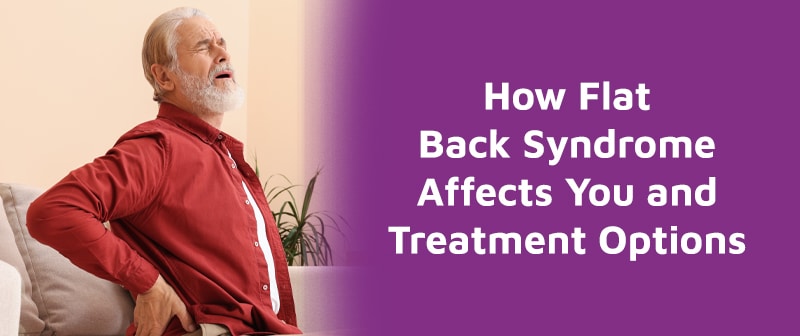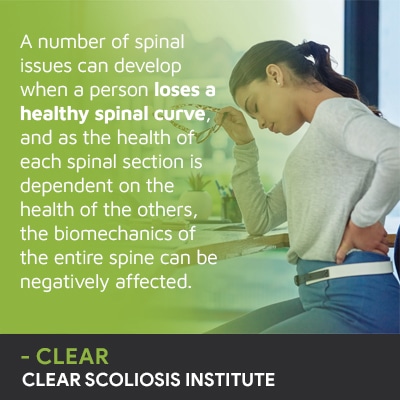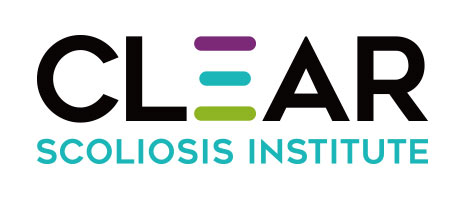
Spinal health is shaped by a number of factors, including whether or not its healthy curves and alignment are in place. A healthy spine will be curved at each of its main sections, and if the spine loses one or more of these natural curves, it can affect spinal health and quality of life in a number of ways.
Flatback syndrome involves a loss of the spine's healthy curves, causing the spine to become excessively straight and posture to develop a pitched-forward inclination. Flatback syndrome can affect the body in a number of ways, including back pain and mobility issues.
The loss of a single healthy spinal curve is capable of causing spinal instability, so let's first discuss the difference between a healthy and unhealthy spinal curve.
The human spine can be divided into three main sections: the cervical spine, thoracic spine, and the lumbar spine.
The cervical spine refers to the neck, thoracic refers to the middle and upper back, and the lumbar spine includes the lower back.
In a healthy spine, each section has its vertebrae aligned and its healthy curves in place, and this keeps the spine balanced, stable, and strong.
A healthy spine has an 'S' shape when viewed from either side and will appear straight when viewed from the front and/or back; it's the spine's natural curvature types that give it its S-shaped structure.
There are two main types of curvatures known as the lordosis and kyphosis, and while these curvature types can range in size from person to person, if a person experiences a loss of lordosis, kyphosis, or both, the spine's curves are no longer considered healthy and can become problematic.

Lordotic curves are found in the cervical and lumbar spinal sections, and kyphosis is the thoracic spine's curvature type.
Not everyone will have the same size of spinal curves; somewhat of a range is normal, but if a person's lordosis, kyphosis, or both are lost or excessive, the curves can become problematic.
A typical range of cervical lordosis would fall within a range of 20 to 40 degrees, and normal lumbar lordosis is considered to be between 40 and 60 degrees; a normal range of thoracic kyphosis is between 20 and 40 degrees.
A loss of normal lumbar lordosis is a common cause of an excessively flat back.
A number of spinal issues can develop when a person loses a healthy spinal curve, and as the health of each spinal section is dependent on the health of the others, the biomechanics of the entire spine can be negatively affected.
So what happens if a person's healthy degree of lordosis, kyphosis, or both are lost?
When the spine is unnaturally straight, it has lost one or more of its healthy curves, and this causes a forward tilt that affects posture and the ability to stand upright.
Many patients with flatback syndrome describe the disruption to their upright posture as a constant sensation of falling forward.
People with flatback syndrome won't have an economical gait because the excessively-straight spine disrupts its balance and stability and the related pitched-forward posture means the torso's weight isn't evenly distributed over the pelvis and legs.
A flatback deformity can disrupt the spine's sagittal balance causing pain, muscle fatigue, a pronounced pitched-forward posture, fatigue, and disruptions to balance, coordination, and gait: all effects capable of disrupting a patient's quality of life.
Walking with a cane can help evenly distribute weight and counteract imbalance and instability, and muscle pain can be severe as the muscles that surround the spine have to provide it with support and stability; the spine can't maintain its healthy curves on its own.
The spine is a complex structure that wants to stay balanced, and in some cases, when an unhealthy spinal curve develops, the spine responds by adding a compensatory curve elsewhere in an attempt to counteract the uneven forces of the first unhealthy curve.
In short, other spinal issues, such as forward head posture, can develop as a related complication of flatback syndrome.

If the spine has lost its normal lordosis in the lower back, the cervical spine can also be affected.
If the lower back is excessively straight, postural changes can shift the head forward in an attempt to counteract the instability, and this can cause issues for the cervical spine.
If the head shifts forward one inch, it's estimated that the weight of the head on the neck increases by 10 pounds; it's the cervical spine's job to adequately support the weight of the head and facilitate the neck's range of motion.
As unhealthy spinal curves also disrupt the spine's surrounding muscle strength and balance, forward head posture affects the cervical spine's surrounding muscles by making them less able to support and stabilize the cervical spine.
Symptoms of forward head posture can include stiff and sore neck and upper back muscles, shoulders, and tension headaches.
The longer a flat back is left untreated, the more likely it is to cause related complications like forward head posture, and this is one of the main benefits of proactive treatment; it works towards immediately addressing the unbalance and preventing increasing effects and potential complications.
Treatment for flatback syndrome will be about restoring/improving the spine's healthy curves, balance, and stability.
At the CLEAR Scoliosis Institute, nonsurgical treatment options address a number of spinal conditions that involve a loss of healthy spinal curves and alignment.
If the spine has its natural curves in place, its vertebrae (bones) are aligned in a straight and neutral position, but if an unhealthy curve develops, this involves a number of vertebral bodies becoming misaligned from the rest of the spine.
And once degenerative changes start to affect the spine with increasing age, a spinal imbalance can worsen quickly and significantly: another reason to be proactive with treatment.
Nonoperative treatment for flatback syndrome includes a conservative chiropractic-centered approach that combines the power of chiropractic care, physical therapy, and scoliosis exercises.
If the flat back has developed due to a straightening of the lumbar spine, the lower back's healthy curve has to be restored to rebalance the spine, and this can be worked towards through spinal manipulation (precise manual adjustments and remodeling) capable of improving the alignment of the lower lumbar spine.
Physical therapy and condition-specific exercises are used to improve the spine's surrounding muscle strength and balance so they can provide more support/stability for the spine and improve posture.
Surgical correction of flatback syndrome can include an extension osteotomy, spinal fusion, disc replacement and decompression surgery to increase disc space, but surgical treatments can be costly, invasive, and risky.
So flatback syndrome can affect you by disrupting your posture, balance, gait, and causing muscle and back pain, and if left untreated, it can cause additional spinal issues to develop over time.
As a common factor in the development of flatback syndrome is a straightening of the lumbar spine, restoring the lower back's healthy and natural curve can mean improving the spine's structure and biomechanics.
A spine that has its healthy curves in place is one that's balanced, stable, and has its vertebrae aligned; these factors shape the spine's ability to function optimally.
If flatback syndrome is left untreated, it can lead to the development of additional spinal issues such as forward head posture, and this can further disrupt the spine's balance and stability as the cervical spine is also affected.
The first step to treating any spinal condition is determining its underlying cause and customizing treatment plans around it, and this commonly involves a physical examination and x ray imaging.
A diagnosis of flatback syndrome means there is a loss of normal lordosis in the lumbar spine, and this can cause an inability to fully stand upright, leg pain, thigh pain, difficulty standing for long periods of time, excessive knee bending as part of an uneconomical gait, and chronic hip flexion making the hips sore, stiff, and painful.
As a CLEAR-certified scoliosis chiropractor, I want to help patients address their spinal issues with non-surgical options capable of preserving the spine's natural flexibility, strength, and balance.

CLEAR provides a unique and innovative way of understanding scoliosis. Sign up to receive facts and information you won’t find anywhere else.
